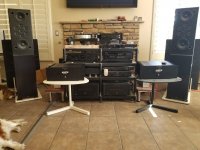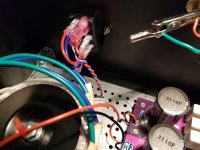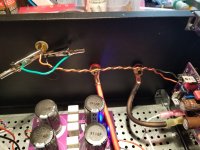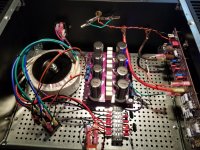Thanks, Randy. You're the best.I thought were going to wait another week to listen. 4 days start to finish is fantastic!
Short the inputs to measure DC Offset. No need for an 8 ohm dummy load for this on the speaker terminals. I imagine based on mosfet matching you won't be turning R1 much or at all.
The Alephs are making music, have been for an hour, and have lots of promise. Got the DC offset in the low 30s for both chassis but it was strange to set -- the value would go down then start coming back up. Had to turn pin 1 quite a bit clockwise to get them settled in the 30s.
The amps sound superb with one major issue -- there is hum/buzz in both. Am assuming this is from the calibration yet to be done and am looking over that info.
These run hot indeed. They measure around 54-56 after an hour. Used Anand's idea of thermal paste to transfer the heat to the front panel and it reads 47 over the heatsink, to about 36 in the middle, then 27 at the unused side heatsink. As long as it stays below 60 will not be upset but have been told that once you get higher than 60 it's good to have a fan.
Initial listening response is that there is one major characteristic -- like my ACA amp, individual instruments/voices are very sharply defined and, so, there is lots of space between them in the soundstage. Audiophiles say "air" or "transparent,' or "tight." Very much like an uptown version of the ACA here. Plenty of punch and clean attacks. As mentioned above, this occurs naturally and the power and attacks are easy on the ear.
So time to investigate the calibration issues. Will be boring you folks with additional ideas/questions over the next couple of days.
The amps sound superb with one major issue -- there is hum/buzz in both. Am assuming this is from the calibration yet to be done and am looking over that info.
These run hot indeed. They measure around 54-56 after an hour. Used Anand's idea of thermal paste to transfer the heat to the front panel and it reads 47 over the heatsink, to about 36 in the middle, then 27 at the unused side heatsink. As long as it stays below 60 will not be upset but have been told that once you get higher than 60 it's good to have a fan.
Initial listening response is that there is one major characteristic -- like my ACA amp, individual instruments/voices are very sharply defined and, so, there is lots of space between them in the soundstage. Audiophiles say "air" or "transparent,' or "tight." Very much like an uptown version of the ACA here. Plenty of punch and clean attacks. As mentioned above, this occurs naturally and the power and attacks are easy on the ear.
So time to investigate the calibration issues. Will be boring you folks with additional ideas/questions over the next couple of days.
Here's a photo showing the "not ready yet" positioning of the Aleph's. They will get stands so that the tube 300Bs and they are arranged in a vertical stand with plenty of room to breath.
Realized that by putting the spring supports under the current legs I can probably drop the temp by around 4 degrees -- this is what I use with the M2xs.
Another listening response: have been throwing some really large orchestral crescendos at the amps (from high-end vinyl sources) and they "unpack" very dense textures better than the other amps I have -- meaning that the orchestral sections are better defined and the crescendos approach the live listening quality better. Good noise. Now if I can address the humming...
Realized that by putting the spring supports under the current legs I can probably drop the temp by around 4 degrees -- this is what I use with the M2xs.
Another listening response: have been throwing some really large orchestral crescendos at the amps (from high-end vinyl sources) and they "unpack" very dense textures better than the other amps I have -- meaning that the orchestral sections are better defined and the crescendos approach the live listening quality better. Good noise. Now if I can address the humming...
Attachments
Craig,
see this link:
https://hifisonix.com/wordpress/wp-content/uploads/2019/02/Ground-Loops.pdf
Twist those wires!
see this link:
https://hifisonix.com/wordpress/wp-content/uploads/2019/02/Ground-Loops.pdf
Twist those wires!
Thanks Randy. Have twisted at least some of them. The left Aleph is louder than the right one and I suspect the difference is in the DC Offset. Can take this down to zero, probably, but it is going to require a lot of clockwise turns on F1. Is that a good idea? Do the other calibrations affect the DC Offset reading after they are made?
Just gave the Aleph's my acid test for orchestral volume: Bruckner's 3rd movement (scherzo) to the 4th symphony. Huge crescendos mirrored by "off-the-stage" quiet horn calls. Got to have the best in loud and soft amplification to make this work and the Alephs shine here. Added the spring stands underneath and the temps went down to 53.
Am going to Ikea now and hoping I get lucky and find a stand. Hoping to avoid another build project.
Just gave the Aleph's my acid test for orchestral volume: Bruckner's 3rd movement (scherzo) to the 4th symphony. Huge crescendos mirrored by "off-the-stage" quiet horn calls. Got to have the best in loud and soft amplification to make this work and the Alephs shine here. Added the spring stands underneath and the temps went down to 53.
Am going to Ikea now and hoping I get lucky and find a stand. Hoping to avoid another build project.
Can you post pix of both amps and the twisted wires.
P1 isn't going to change hum. If you're measuring lower than 100mV of DC Offset, call that portion of the setup done.
Read the PDF on grounding and hum. Did you loosen up the donut bolt and slowly rotate the donut to get to the lowest hum? Did you move around the twisted wire bundles to see if you get a loud or quiet way of dressing the wires?
Curious what you find at Ikea. I take pleasure making "Ikea hacks" from time to time.
P1 isn't going to change hum. If you're measuring lower than 100mV of DC Offset, call that portion of the setup done.
Read the PDF on grounding and hum. Did you loosen up the donut bolt and slowly rotate the donut to get to the lowest hum? Did you move around the twisted wire bundles to see if you get a loud or quiet way of dressing the wires?
Curious what you find at Ikea. I take pleasure making "Ikea hacks" from time to time.
Last edited:
Here you go. This is the louder of the two alephs. In Twist1 you see the "L" and "N" from the AC twisted, then it goes under the baseplate and comes back up right under the front toggle switch -- where there is no room for twisting before it goes to the block that adds the CL60s and sends them out to the 2 transformer AC ins. The Twist2 shows the RCA connection from the board to the RAC input -- twisted 22awg. There is no possibility of twisting the speaker outputs. The short leads from the rectifiers to the PSU PCB can be twisted but because they are so short (see the Full Innards pic) don't see any reason why. John , from Antek, told me that the purple cable we discussed above had the purpose of lowering hum and you see it goes direct to the PSU PCB. Lowered the DC offset to the high-teens mv value and wil conect the amp back up and see if that reduced the noise. More a noise than a hum I would say.
Again, can F2 or F3 create any kind of noise when not correctly adjusted? Also, the amp works fine otherwise.
Thanks as always.
Again, can F2 or F3 create any kind of noise when not correctly adjusted? Also, the amp works fine otherwise.
Thanks as always.
Attachments
I can't tell where your earth ground is, but I believe the trafo shield wire should be connected directly to it. You also might try using a spare tapped hole on each heat sink to run a ground wire to the chassis base plate. Tying all these together (chassis grounds, trafo shield, and earth ground) would give you a so-called star ground.Here you go. This is the louder of the two alephs. In Twist1 you see the "L" and "N" from the AC twisted, then it goes under the baseplate and comes back up right under the front toggle switch -- where there is no room for twisting before it goes to the block that adds the CL60s and sends them out to the 2 transformer AC ins. The Twist2 shows the RCA connection from the board to the RAC input -- twisted 22awg. There is no possibility of twisting the speaker outputs. The short leads from the rectifiers to the PSU PCB can be twisted but because they are so short (see the Full Innards pic) don't see any reason why. John , from Antek, told me that the purple cable we discussed above had the purpose of lowering hum and you see it goes direct to the PSU PCB. Lowered the DC offset to the high-teens mv value and wil conect the amp back up and see if that reduced the noise. More a noise than a hum I would say.
Again, can F2 or F3 create any kind of noise when not correctly adjusted? Also, the amp works fine otherwise.
Thanks as always.
Here you go. This is the louder of the two alephs. In Twist1 you see the "L" and "N" from the AC twisted, then it goes under the baseplate and comes back up right under the front toggle switch -- where there is no room for twisting before it goes to the block that adds the CL60s and sends them out to the 2 transformer AC ins. The Twist2 shows the RCA connection from the board to the RAC input -- twisted 22awg. There is no possibility of twisting the speaker outputs. The short leads from the rectifiers to the PSU PCB can be twisted but because they are so short (see the Full Innards pic) don't see any reason why. John , from Antek, told me that the purple cable we discussed above had the purpose of lowering hum and you see it goes direct to the PSU PCB. Lowered the DC offset to the high-teens mv value and wil conect the amp back up and see if that reduced the noise. More a noise than a hum I would say.
Again, can F2 or F3 create any kind of noise when not correctly adjusted? Also, the amp works fine otherwise.
Thanks as always.
More ideas:
Twist all the DC wiring tightly, too.
- Transformer secondaries.
- Rectifiers to PSU board.
- PSU to amp board.
Consider moving that CL60 barrier strip to corner away from amp PCB. Did you get a CL60 Pcb?
Did you do the "rotate the donut" thing yet? That has a big effect.
That article I linked above has decades of hum busting-wisdom in it - it's gold.
GOT IT! Turns out it was the wall outlet chosen. Am running out of Furman outlets so I plugged this directly into the wall -- that is, I think, a different path back to the main box than the other equipment. So pulled some plugs and inserted the Aleph into the Furman pfi-15. Deathly quiet.
SO SORRY to have bothered you folks with this. Can now get onto some serious listening -- and buying another Furman conditioner.
Never you mind, Randy (LOL).
SO SORRY to have bothered you folks with this. Can now get onto some serious listening -- and buying another Furman conditioner.
Never you mind, Randy (LOL).
@Craigl59
Good job sleuthing and finding out that plugging the amp into the Furman conditioner cleans up the buzz. Most likely the buzz wasn't hum but perhaps DC present on your mains and the Furman squashed it.
Now...please tell us in many words your sonic experiences with the Aleph 30 monoblocks!
P.S. Just another tip. Since you have your twisted wire of your AC mains going into the baseplate hole and then coming back out, perhaps consider enlarging those holes and putting a rubber grommet or two so that the mains wires don't accidentally get scratched/loose their insulation especially during transport/etc...i.e. safety is terribly important. You don't want a baseplate energized at 120V AC. Those baseplate holes are nice to have but they can be sharp too. I see that you have a nice safety measure on your terminal strip with a plastic cover for insulation and prevention of accidental shock on curious fingers.
Best,
Anand.
Good job sleuthing and finding out that plugging the amp into the Furman conditioner cleans up the buzz. Most likely the buzz wasn't hum but perhaps DC present on your mains and the Furman squashed it.
Now...please tell us in many words your sonic experiences with the Aleph 30 monoblocks!
P.S. Just another tip. Since you have your twisted wire of your AC mains going into the baseplate hole and then coming back out, perhaps consider enlarging those holes and putting a rubber grommet or two so that the mains wires don't accidentally get scratched/loose their insulation especially during transport/etc...i.e. safety is terribly important. You don't want a baseplate energized at 120V AC. Those baseplate holes are nice to have but they can be sharp too. I see that you have a nice safety measure on your terminal strip with a plastic cover for insulation and prevention of accidental shock on curious fingers.
Best,
Anand.
Anand: Thanks for the info. Am using a rubber grommet for the transformer hole (1/2") and keep that bolt entirely free from the chassis and any ground. Have had the same thought about the wires going through the base plate and will consider that next time. Hope you saw my post above that mentions heat and the use of thermal paste -- NT-H1. After placing the amps on spring supports to raise them, they are averaging 54 C after an hour or two. This is one hot amp as has been noted. As long as it stays in the 50s, it is fine. The front plate is around 46 C where it joins the active heatsink, then cools to 36 C at the middle and to 27 C on the other, unused heatsink side. So the transfer is there but the faceplate is not providing much additional cooling, I suspect.
Am working on the supports and placement issues today and tomorrow and will be providing my listening analysis after having time to go through a series of checks and comparisons with the other 4 amps -- the ACA, M2x, 300B, and the Emotiva XPA-1. So far, have determined that the amp shares with the ACA a very tightly-focused soundstage and this is one of its main characteristics. Timbral accuracy will be a key here. Both the ACA and M2x are OK here but not superb as is the 300B. Checks done last night suggest that solo voices are VERY accurate with the Aleph. John Mayer's new offering on vinyl 'Sob Rock' provides his voice with a different character than the other amps -- slightly more nasal and accurate. This is, BTW, one superb album.
So hold on until the weekend and will provide some additional posts at that time.
Am working on the supports and placement issues today and tomorrow and will be providing my listening analysis after having time to go through a series of checks and comparisons with the other 4 amps -- the ACA, M2x, 300B, and the Emotiva XPA-1. So far, have determined that the amp shares with the ACA a very tightly-focused soundstage and this is one of its main characteristics. Timbral accuracy will be a key here. Both the ACA and M2x are OK here but not superb as is the 300B. Checks done last night suggest that solo voices are VERY accurate with the Aleph. John Mayer's new offering on vinyl 'Sob Rock' provides his voice with a different character than the other amps -- slightly more nasal and accurate. This is, BTW, one superb album.
So hold on until the weekend and will provide some additional posts at that time.
Woooooooo!Here's a photo showing the "not ready yet" positioning of the Aleph's.
Slightly OT, but would you mind sharing here or via PM how you added the height to your bottom stands, please. I have similar VTI racks, and I'd love a bit more breathing room for 5Us when placed on the bottom. As of now, 4Us are fine, but anything taller will 'fit', but I don't like it, so 5U's must go on top.
Again, congrats on the build! Hope you enjoy the tunes!

IAIMH: This is a good question. Needed extra height in the lowest rack for the AC Infinity fans to keep the Emotiva amps at around 95 F. So I took the pointed, sharp end of the VTI rod to Home Depot and got a 3" bolt with the same metric thread. Then it just screws into the same nut with a locking nut added, AND the head of the bolt is fastened to the bottom round area with black velcro. Is VERY stable and will not rock or move. Am doing it on both of my VTI racks. The velcro allows you to pull it apart if needed. You are one observant DIYer, IAIMH! Feel free to PM anytime.
The Ac Infinity fans are designed to pass air in the direction you choose and I use them here out the back. In my studio, have the need to cool down Dolby SR units (five of them) in an audio rack and so I use their rack cooling modules. They are all "smart" and you can set the temp desired along with a number of other options.
Have got half of the Aleph 30 redo finished and will be posting a pic of the final setup along with the music summary this weekend. Working out great. cleaner and
And, BTW, the Alephs are the quietist amp I have heard; at the same time they are also susceptible to slightly "dirty" electricity and show hum more than my other amps -- as noted above. Use a Furman-like conditioner and there is no noise at all.
The Ac Infinity fans are designed to pass air in the direction you choose and I use them here out the back. In my studio, have the need to cool down Dolby SR units (five of them) in an audio rack and so I use their rack cooling modules. They are all "smart" and you can set the temp desired along with a number of other options.
Have got half of the Aleph 30 redo finished and will be posting a pic of the final setup along with the music summary this weekend. Working out great. cleaner and
And, BTW, the Alephs are the quietist amp I have heard; at the same time they are also susceptible to slightly "dirty" electricity and show hum more than my other amps -- as noted above. Use a Furman-like conditioner and there is no noise at all.
Last edited:
- Home
- Amplifiers
- Pass Labs
- Classic Aleph Amplifier for Modern UMS Chassis Builder's Thread



